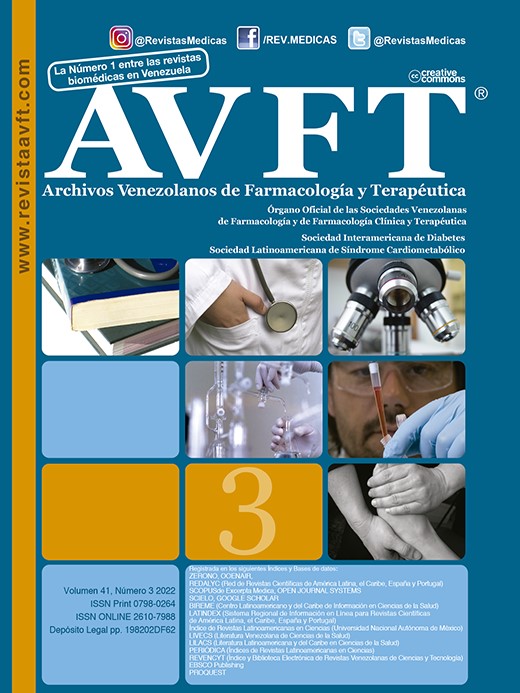Antibacterial activity of Punica granatum “pomegranate” rind against Staphylococcus aureus biofilm producers
Keywords:
S. aureus, biofilms, Punica granatumAbstract
Objective: To determine the activity of the ethanolic extract of Punica granatum rind against biofilm formers Staphylococcus aureus. Materials and methods: Coloration and precipitation reactions: To determine secondary metabolites. Microbiological study: With 30 strains isolated from catheters and S. aureus ATCC® 25923 biofilm former as control strain. Congo red agar: To identify biofilm producers strains. Determination of the minimum inhibitory concentration (MIC): By the colorimetric microdilution with extract dilutions (2000- 3.9 µg/mL). Results: Reducing sugars, flavonoids and phenolic compounds were identified. It was determined that 67% of the strains had the ability to form biofilms. The MICs of the extract showed weak, moderate and good activity against 40, 45 and 15% of the strains. Conclusion: The ethanolic extract of the Punica granatum rind showed activity against strains of S. aureus biofilms producers.
Downloads
References
Antunes ALS, Trentin DS, Bonfanti JW, Pinto CCF, Perez LRR, Macedo AJ, et al. Application of a feasible method for determination of biofilm antimicrobial susceptibility in staphylococci. APMIS. 2010; 118(11):873-7. doi:10.1111/j.1600-0463.2010.02681.x.
MINSA. R.M. N°523-2020-MINSA. Norma Técnica de Salud para la Vigilancia de las Infecciones Asociadas a la Atención de la Salud. Perú.
WHO | WHO traditional medicine strategy: 2014-2023 [Internet]. WHO. [Citado 2 de marzo de 2019]. Disponible en: http://www.who.int/medicines/publications/traditional/trm_strategy14_23/en/
Macià MD, del Pozo JL, Díez-Aguilar M, Guinea J. Diagnóstico microbiológico de las infecciones relacionadas con la formación de biopelículas. Enfermedades Infecciosas y Microbiología Clínica. 2018; 36(6):375-81.
Jacob J, Gopalan R, Lakshmanaperumalsamy P, Illuri R, Bhosle D, Sangli GK, et al. Evaluation of Anti-psoriatic Potential of the Fruit Rind of Punica granatum L. Pharmacog J. 2019; 11 (3): 466-468.
Tandokazi P, Nokwanda P, Olaniyi A, Umezuruike L. Processing factors affecting the phytochemical and nutritional properties of Pomegranate (Punica granatum L.) peel waste: a review. Molecules. 2020; 25: -34. doi: 10.3390/molecules25204690.
Madugula P, Reddy S, Koneru J, Srinivasa A, Sruthi R, Teja D. “Rhetoric to Reality”-Efficacy of Punica Granatum peel extract on oral candidiasis: an in vitro study. J Clin Diagn Res. 2017; 11(1): Z114-7. doi: 10.7860/JCDR/2017/22810.9304.
Lock O. Investigación fitoquímica. Métodos en estudios de productos naturales. Segunda edición. Lima: Fondo Editorial de la Pontificia Universidad Católica del Perú, Lima; 1994.
Freeman DJ, Falkiner FR, Keane CT. New method for detecting slime production by coagulase negative staphylococci. J Clin Pathol. 1989; 42: 872-4.
Sarker SD, Nahar L, Kumarasamy Y. Microtitre plate-based antibacterial assay incorporating resazurin as an indicator of cell growth, and its application in the in vitro antibacterial screening of phytochemicals. Methods. 2007; 42 (4): 321-4. doi: 10.1016/j.ymeth.2007.01.006
Machado P, Vasconcelos FR, Terceiro R, Mendes M, De Morais SM, Machado S, et al. Screening of Bioactivities and Toxicity of Cnidoscolus quercifolius Pohl. Evid Based Complement Alternat Med. 2016; 1-9. doi: 10.1155/2016/7930563
Holetz FB, Pessini GL, Sanches NR, Cortez DAG, Nakamura CV, Dias Filho BP. Screening of some plants used in the Brazilian folk medicine for the treatment of infectious diseases. Memórias do Instituto Oswaldo Cruz. 2002; 97(7): 1027-31. doi: 10.1590/S0074-02762002000700017
Ko K, Dadmohammadi Y, Abbaspourrad A. Nutritional and bioactive components of Pomegranate waste used in food and cosmetic applications: a review. Foods. 2021; 10, 657. doi: 10.3390/foods10030657
Akhtar S, Ismail T, Fraternale D, Sestili P. Pomegranate peel and peel extracts: Chemistry and food features. 2015. Food Chemistry 174: 417-425. doi:10.1016/j.foodchem.2014.11.035
Viuda-Martos M, Fernández-López J, Pérez-Álvarez JA. Pomegranate and its many functional components as related to human health: a review. Comprehensive reviews in Food Science and Food Safety. 2010; 9: 635-654. doi: 10.1111/j.1541-4337.2010.00131.x
Salazar M, Crispín V. Biopelículas y gene icaA e icaD en estafilococos coagulasa negativos aislados de catéter endovenoso central en Unidad de Cuidados Intensivos de un Hospital de Nivel III en Lima, Perú. Horizonte Médico2018; 18(3):19-24.
Shrestha L, Bhattarai NR, Khanal B. Antibiotic resistance and biofilm formation among coagulase-negative staphylococci isolated from clinical samples at a tertiary care hospital of Eastern Nepal. Antimicrobial Resistance and Infection Control.2017; 89:1-7. doi: 10.1186/s13756-017-0251-7
Abdel R, Kassem N, Mahmoud B. Detection of biofilm producing Staphylococci among different clinical isolates and its relation to methicillin susceptibility. Macedonian Journal of Medical Sciences. 2018; 6(8): 1335-1341. doi: 10.3889/oamjms.2018.246
Mishra SK, Basukala P, Basukala O, Parajuli K, Pokhrel BM, Rijal BP. Detection of biofilm production and antibiotic resistance pattern in clinical isolates from indwelling medical devices. Curr Microbiol. 2015; 70(1): 128-134.
Neopane P, Prasad H, Shrestha R, Uehara O, Abiko Y. In vitro biofilm formation by Staphylococcus aureus isolated from wounds of hospital_admitted patients and their association with antimicrobial resistance. International Journal of General Medicine 2018; 11:25-32.
Kisla D, Karabiyikli S. Antimicrobial effect of sour pomegranate sauce on Escherichia coli O157:H7 and Staphylococcus aureus. J Food Sci. 2013; 78(5):M715-8. Doi: 10.1111/1750-3841.12099.
Khan JA, Hanee S. Antibacterial properties of Punica granatum peels. International Journal of Applied Biology and Pharmaceutical Technology. 2011; 2:23-27.
Pramadita J, Widyarman AS. In vitro antibiofilm activity of Pomegranate (Punica granatum) juice on oral pathogens. Journal of Indonesian Dental Association. 2019; 2(1):15-20. doi: 10.32793/jida.v2il.353
Downloads
Published
How to Cite
Issue
Section
License
Copyright (c) 2023 AVFT – Archivos Venezolanos de Farmacología y Terapéutica

This work is licensed under a Creative Commons Attribution-NonCommercial-NoDerivatives 4.0 International License.




